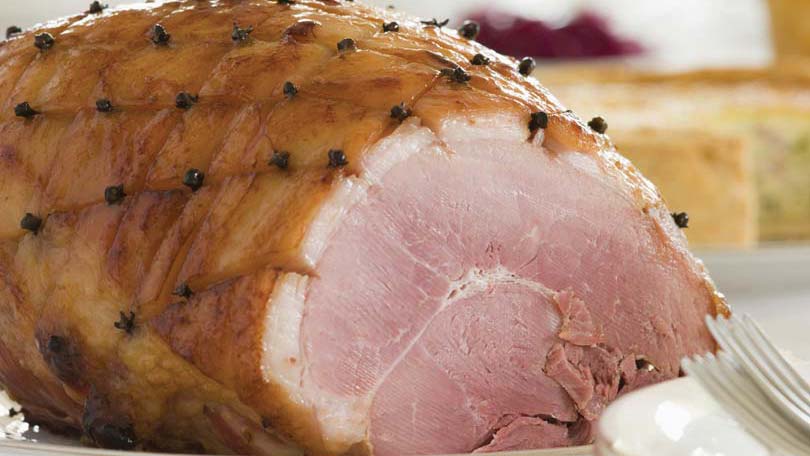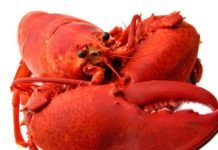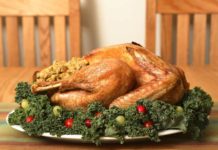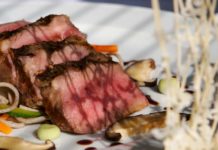
All hams begin as a roast from the hind leg of a hog, which is called a fresh ham. Before this roast is prepared, it is no different from any other pork roast. Because hams are prepared in several different ways, how it gets to be a ham is a rather complicated process. They can be aged, cured, smoked or cooked. The ham you buy at the store is generally wet or brine cured. This process involves injecting the ham with a combination of salt, sugar, sodium nitrite, sodium erythorbate, sodium phosphate, potassium chloride, water, and flavorings. Then the ham is cooked to a temperature of 150 degrees F. The combination of the chemical brine and the cooking will kill off bacteria and make a ham safe to eat.
The Curing Process
Ham can be either dry-cured or wet-cured. A dry-cured ham has been rubbed in a mixture containing salt and a variety of other ingredients in cluding sodium nitrate. Sugar is a common way to dry cure ham in the United States, which is followed by a period of drying and aging. Dry-cured hams may require a period of rehydration prior to consumption. A wet-cured ham has been cured with brine, by either immersion or injection. The division between wet and dry cure is not always fixed as some ham curing methods begin wet but are followed by dry aging.
Aging
The hams are hung in a special room with exact temperature and humidity controls. They can spend as much as 5 years aging. Eventually, they will come out coated in a hard mold crust, which must be scrapped off and then thoroughly washed before eaten. Aging is done at about 75 degrees F to 95 degrees F at a humidity level between 55%-65% for at least 45 days. Good air circulation is required to keep the surface of the meat dry and to reduce mold growth.
Cold Smoking
Cold smoking is done at temperatures less than 100 degrees F and can go on for days or even weeks. Because the temperature is a so low, bacteria are controlled by chemicals in the smoke and the slow drying process. A cold smoked ham requires salt curing, typically in a brine, to keep the bacteria under control while the ham cures.
Many hams are prepared through a combination of these processes. The Smithfield Ham, which can sell for $7 to $15 a pound, uses all of the above ways to preserve meat. If you want to make your own Smithfield Ham, start with the hind leg of a hog raised entirely on a diet of peanuts. Soak the ham in a saltwater brine mixture for 1 to 2 months, smoke for a week, then let the ham age for another 6 months. This long process is why the price is so high.
The majority of the common wet-cured hams available in U.S. supermarkets are the “city ham” variety, in which brine is injected into the meat for a very rapid curing suitable for the mass market. Traditional wet curing requires immersing the ham in brine for an extended period, often followed by light smoking.
Ham, a popular deli meat, includes the dry-cured varieties such as Italian prosciutto and the Spanish Jamon Serrano. The United States has a country ham, which might or might not be smoked. Smithfield ham or country ham is typically a salty variety of cured ham associated with the the Southern United States, particularly Virginia. The curing process originated in Smithfield, Virginia.
Country Ham
Country hams are cured in salt and saltpeter for about a month, and then smoked in hardwood such as hickory or red oak. After that, they are aged from several months to upwards of a year. Whole country hams must be scrubbed and soaked for many hours prior to consumption in order to remove the salt cure and mold, otherwise they will be too salty to eat. Even when soaked properly, they are still quite salty. They are usually sold in stores un-refrigerated as whole bone-in hams packaged in rough cotton bags, with identifying markings printed on the bags. Country ham is also sold in ready-to-cook pre-soaked, pre-sliced packages, usually vacuum-packed plastic sheets.
Serving Suggestions
There are several ways to dress up a prepared ham that will add flavor and improve the quality of the ham. When serving a precooked ham for a formal gathering, push in a dozen or so whole cloves, top with pineapple slices, glaze with a nice mustard sauce and bake in the oven at 350º F for a couple of hours, depending on the size. This will heat the ham and add some flavor. To really dress up the ham, try it on the grill or in the smoker. For some other ideas, try either a honey glaze on a smoked ham or maple mustard on the baking ham. Either can add zest to the flavor. Additionally, grated horseradish in the maple mustard sauce really livens up the flavor.
Nutritional Values Based on a 3 oz. Boneless Serving
Lean Cured ham has 140 calories, 6.5 grams of total fat, 2.2 grams of saturated fat, 18.7 grams of protein, and 48 milligrams of cholesterol.
Extra lean cured ham has 124 calories, 5 grams of total fat, 1.7 grams of saturated fat, 18 grams of protein, and 45 milligrams of cholesterol.





